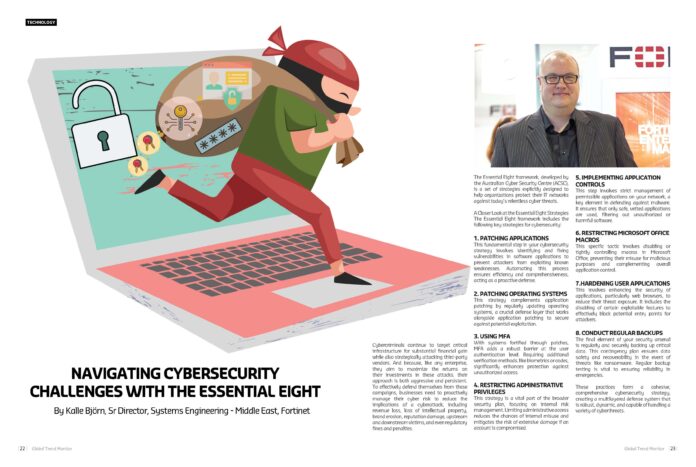By Kalle Björn, Sr Director, Systems Engineering – Middle East, Fortinet
Cybercriminals continue to target critical infrastructure for substantial financial gain while also strategically attacking third-party vendors. And because, like any enterprise, they aim to maximize the returns on their investments in these attacks, their approach is both aggressive and persistent. To effectively defend themselves from these campaigns, businesses need to proactively manage their cyber risk to reduce the implications of a cyberattack, including revenue loss, loss of intellectual property, brand erosion, reputation damage, upstream and downstream victims, and even regulatory fines and penalties.
The Essential Eight framework, developed by the Australian Cyber Security Centre (ACSC), is a set of strategies explicitly designed to help organizations protect their IT networks against today’s relentless cyberthreats.
A Closer Look at the Essential Eight Strategies
The Essential Eight framework includes the following key strategies for cybersecurity:
- Patching applications: This fundamental step in your cybersecurity strategy involves identifying and fixing vulnerabilities in software applications to prevent attackers from exploiting known weaknesses. Automating this process ensures efficiency and comprehensiveness, acting as a proactive defense.
- Patching operating systems: This strategy complements application patching by regularly updating operating systems, a crucial defense layer that works alongside application patching to secure against potential exploitation.
- Using MFA: With systems fortified through patches, MFA adds a robust barrier at the user authentication level. Requiring additional verification methods, like biometrics or codes, significantly enhances protection against unauthorized access.
- Restricting administrative privileges: This strategy is a vital part of the broader security plan, focusing on internal risk management. Limiting administrative access reduces the chances of internal misuse and mitigates the risk of extensive damage if an account is compromised.
- Implementing application controls: This step involves strict management of permissible applications on your network, a key element in defending against malware. It ensures that only safe, vetted applications are used, filtering out unauthorized or harmful software.
- Restricting Microsoft Office macros: This specific tactic involves disabling or tightly controlling macros in Microsoft Office, preventing their misuse for malicious purposes and complementing overall application control.
- Hardening user applications: This involves enhancing the security of applications, particularly web browsers, to reduce their threat exposure. It includes the disabling of certain exploitable features to effectively block potential entry points for attackers.
- Conduct regular backups: The final element of your security arsenal is regularly and securely backing up critical data. This contingency plan ensures data safety and recoverability in the event of threats like ransomware. Regular backup testing is vital to ensuring reliability in emergencies.
These practices form a cohesive, comprehensive cybersecurity strategy, creating a multilayered defense system that is robust, dynamic, and capable of handling a variety of cyberthreats.
